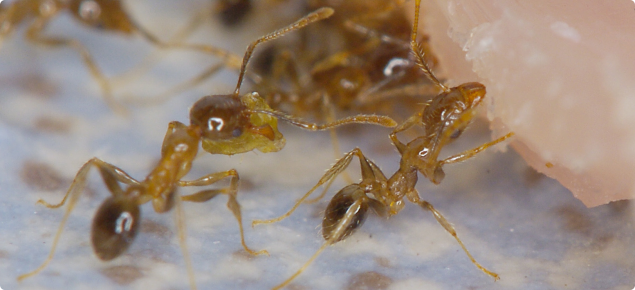Description
The coastal brown is an introduced ant species of African origin. Look for:
- Small, light ginger-brown coloured ants, with shiny dark brown abdomens.
- The presence of two very different-sized ‘castes’ (types determined by their function) of worker ants, that is:
- Smaller ‘minors’ — 2 to 3mm long.
- A larger ‘major’ caste — 3.5 to 4.5mm long, which has a very obvious, much larger head and which makes up about 1% of the population. The ‘major’ caste of worker ants are not primarily soldiers for defence. Instead, their powerful jaws are used for cutting up large pieces of food into small pieces which can more easily be transported back to the nest by the more numerous minors.
- Ants with no obvious odour when crushed.
Biology
There are multiple queens in the nests which are interconnected. New colonies are formed by budding whereby one or more queens with attendant workers leave an existing nest and walk to a nearby location. Rarely are new nests established by flying, mated queen ants.
While these ants can sting, the sting does not cause discomfort to people. Big-headed ants are particularly active in late summer, autumn and early winter. They nest outside in the ground and only occasionally invade buildings when populations outside are very high. However, invasions of buildings can be severe. These ants prefer meat or fat/oil-based foods.
Big-headed ants can form ‘super-colonies’ when their interconnected nests act as a single colony. The worker ants of such an infestation can occupy many hectares and they cooperate in ways similar to a single colony. In these situations they can displace native ant species and be the only ant species present in a heavily infested area. Big-headed ants are specialists in invading disturbed areas and are therefore ideally suited to urban developments. There are native species belonging to the genus Pheidole but these are rarely ever pests, and tend to be found in undisturbed habitats where they are predominantly seed-harvesters.
Symptoms
Infestations of big-headed ants are characterized by lines of inter-connected holes and small mounds of excavated soil. Excavations can be so extensive that brick paving is destabilised and the roots of plants and the lawn can become so aerated that the plants subsequently die by drying out. Often the small worker ants are hard to see, but food put out for pets can become covered in ants.
Look for two distinctly different-sized ants on a food source, with the larger worker ants having a disproportionately larger head.
Identification
Correct identification of the ants is crucial before commencing any control procedures. The Department of Primary Industries and Regional Development provides a free identification and advisory service.
Spray some ants with fly spray and stick about a dozen specimens, with clear sticky-tape, to a piece of paper containing your contact details. Ensure the surface the ants are collected from is clean to prevent picking up sand and other debris.
Send specimens to the address listed at the end of this page.
You can also report or send an image of a suspect pest or disease using the MyPestGuide suite of apps.


